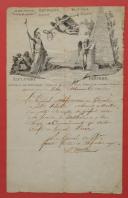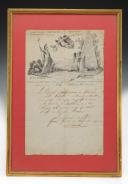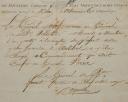
SIGNED AUTOGRAPH LETTER ON THE LETTERHEAD OF DIVISION GENERAL ALEXANDRE BERTHIER, General Headquarters in Milan on the 13th of Brumaire, Year 6. 30166
Sold out
AUTOGRAPH LETTER SIGNED ON LETTERHEAD OF GENERAL DE DIVISION ALEXANDRE BERTHIER, General Headquarters of Milan, 13 Brumaire Year 6. 30166
Alexandre Berthier, Chief of Staff of the Army of Italy, dated from the Milan headquarters, 13 Brumaire Year 6.
Important and famous vignette of the Chief of General Staff of the Army of Italy, featured in the work of Auguste BOPPE and Raoul BONNET: "Emblematic Vignettes during the Revolution," Berger-Levrault, Publishers Paris-Nancy 1911, plate 116 page 73. This is one of the most sought-after military vignettes. It is the work of the Italian painter and draughtsman Andrea Appiani, specially created for General de Division Alexandre Berthier.
"The general in chief orders General de Brigade PELLETIER currently in Mantua, to depart upon receipt of this order to proceed to Antibes, and take over the command previously entrusted to General PARRA.
Signed: the general de brigade acting as chief of staff VIGNOLLE."
Dimensions: Height 38 cm x Width 23.5 cm.
In good condition with folds.
Martin DE VIGNOLLE, born on March 18, 1763 in Marsillargues (Hérault), died on November 13, 1824 in Paris, was a French general of the Revolution and the Empire.
Son of Jean de Vignolle and Anne Hue, the count of the Empire belonged to a family named Vignoles or Vignolles, originally from the Cévennes, who had their nobility confirmed in the intendency of Languedoc in 1669.
He entered service on March 12, 1779, as a volunteer in the Barrois regiment, and served in Brittany under the orders of Marshal de Vaux, then became a cadet gentleman on June 18, 1780, in the same regiment. He was appointed as a second lieutenant on July 10, 1784, a lieutenant on September 17, 1791, and a captain on May 22, 1792, in the same unit which became the 91st infantry regiment.
Assigned to the Army of the Alps, he was wounded on June 8, 1793, in the attack on Lignières and on the 12th, he took part in the attack on the Mille-Fourches camp. On June 24, 1793, he was designated to be an adjoint to the general staff of the army, and on February 25, 1794, he received his epaulettes as adjutant-general chief of battalion. On April 28, 1794, at the battle of Saorge, he commanded one of the columns that captured the fortified camp and later contributed to the capture of the Col de Tende, and was promoted to adjutant-general chief of brigade on December 18, 1794.
On June 23, 1795, he was assigned to the army of Italy as the deputy chief of the general staff of General Kellermann, taking part in the affairs at Montenotte on April 12, 1796, and at Dego on April 15. His distinguished conduct at the crossing of the bridge of Lodi on May 10, 1796, earned him the rank of brigadier general on August 3, 1796. He distinguished himself at the battle of Castiglione on August 5, and on November 16, 1796, he received two gunshot wounds at the battle of Arcole.
On January 7, 1797, he took command of the province of Cremona, which he retained until the Treaty of Campo Formio. On October 26, 1797, he became chief of staff of the army of Italy, and on November 6, 1797, he was appointed by Bonaparte as Minister of War of the Cisalpine Republic, a position he held until February 22, 1799. On May 31, 1799, he moved to the army of Naples and on August 4, 1799, he was sent to Nice by General Moreau to form reserve units. On December 13, 1799, he was called to Paris to take up the position of general secretary at the Ministry of War. On April 1, 1800, he was sent to Dijon as assistant to the chief of the reserve army, and on May 25, 1800, he commanded Ivrea, then Milan on June 2. He was present at the crossing of the Mincio on December 25, 1800, and was wounded the following day at Monzambano.
He commanded Milan in January 1801, and was placed on leave on December 9, 1802. On February 3, 1803, he joined the 15th military division, and on April 12, he was appointed to the administration director at the Ministry of War. On July 4, 1803, he was appointed chief of staff of the French army in Batavia and was promoted to the rank of general of division on August 27, 1803. He was made a Knight of the Legion of Honour on December 11, 1803, and a Commander of the Order on June 14, 1804. On August 30, 1804, he became chief of staff of the 2nd corps of the Grande Armée commanded by General Marmont, and in 1806, he followed him during the Dalmatian campaign. He contributed to the rescue of General Lauriston in Ragusa and distinguished himself at the battle of Castel-Nuovo on September 30, 1806. When the Order of the Crown of Iron was established, he was among the 25 generals granted the title of commander.
He was created Baron of the Empire on June 29, 1808, and was granted leave on September 30, 1808. On March 20, 1809, he served as chief of staff to General Beauharnais, and on June 19, he assumed the same role in the army of Italy. He was present at the battle of Essling on May 21-22, 1809, and was wounded at the battle of Wagram on July 6, 1809, by a cannonball which caused him to lose the sight of his right eye and impaired the vision of his left eye. He was made a Count of the Empire on December 31, 1809.
On March 28, 1812, following General Beauharnais' departure for the campaign in Russia, he commanded all troops stationed in Italy, and on April 18, 1813, he commanded the Adige observation corps. On May 8, 1813, he was appointed chief of staff of the army of Italy and raised to the dignity of Grand Officer of the Legion of Honour on December 3, 1813. At the Battle of the Mincio on February 8, 1814, he demonstrated his military talents and received the most flattering praise from Prince Eugène.
Returning to Paris on May 10, 1814, he was appointed a Knight of Saint Louis on June 1 by King Louis XVIII and placed on retirement on September 9, 1815. On March 9, 1816, he received a letter confirming his title of Count and on March 14, 1818, he was transferred to the prefecture of Corsica, leaving on December 15, 1819. He was promoted to Commander of Saint Louis on May 1, 1821, and appointed as a State Councillor in 1822. In 1824, he was elected as a deputy for the Gard department and died in office on November 13, 1824, in Paris. He was buried in Père-Lachaise Cemetery (39th Division).
Louis PELLETIER, born on May 20, 1754, in Saint-Lubin-de-la-Haye (Eure-et-Loir) and died on August 27, 1843, in Montpellier (Hérault), was a French general of the Revolution and the Empire.
François PARRA, born on December 20, 1733, in Belley (Ain), died on March 9, 1821, in the same place, was a general of brigade of the French Revolution.
Alexandre Berthier, Chief of Staff of the Army of Italy, dated from the Milan headquarters, 13 Brumaire Year 6.
Important and famous vignette of the Chief of General Staff of the Army of Italy, featured in the work of Auguste BOPPE and Raoul BONNET: "Emblematic Vignettes during the Revolution," Berger-Levrault, Publishers Paris-Nancy 1911, plate 116 page 73. This is one of the most sought-after military vignettes. It is the work of the Italian painter and draughtsman Andrea Appiani, specially created for General de Division Alexandre Berthier.
"The general in chief orders General de Brigade PELLETIER currently in Mantua, to depart upon receipt of this order to proceed to Antibes, and take over the command previously entrusted to General PARRA.
Signed: the general de brigade acting as chief of staff VIGNOLLE."
Dimensions: Height 38 cm x Width 23.5 cm.
In good condition with folds.
Martin DE VIGNOLLE, born on March 18, 1763 in Marsillargues (Hérault), died on November 13, 1824 in Paris, was a French general of the Revolution and the Empire.
Son of Jean de Vignolle and Anne Hue, the count of the Empire belonged to a family named Vignoles or Vignolles, originally from the Cévennes, who had their nobility confirmed in the intendency of Languedoc in 1669.
He entered service on March 12, 1779, as a volunteer in the Barrois regiment, and served in Brittany under the orders of Marshal de Vaux, then became a cadet gentleman on June 18, 1780, in the same regiment. He was appointed as a second lieutenant on July 10, 1784, a lieutenant on September 17, 1791, and a captain on May 22, 1792, in the same unit which became the 91st infantry regiment.
Assigned to the Army of the Alps, he was wounded on June 8, 1793, in the attack on Lignières and on the 12th, he took part in the attack on the Mille-Fourches camp. On June 24, 1793, he was designated to be an adjoint to the general staff of the army, and on February 25, 1794, he received his epaulettes as adjutant-general chief of battalion. On April 28, 1794, at the battle of Saorge, he commanded one of the columns that captured the fortified camp and later contributed to the capture of the Col de Tende, and was promoted to adjutant-general chief of brigade on December 18, 1794.
On June 23, 1795, he was assigned to the army of Italy as the deputy chief of the general staff of General Kellermann, taking part in the affairs at Montenotte on April 12, 1796, and at Dego on April 15. His distinguished conduct at the crossing of the bridge of Lodi on May 10, 1796, earned him the rank of brigadier general on August 3, 1796. He distinguished himself at the battle of Castiglione on August 5, and on November 16, 1796, he received two gunshot wounds at the battle of Arcole.
On January 7, 1797, he took command of the province of Cremona, which he retained until the Treaty of Campo Formio. On October 26, 1797, he became chief of staff of the army of Italy, and on November 6, 1797, he was appointed by Bonaparte as Minister of War of the Cisalpine Republic, a position he held until February 22, 1799. On May 31, 1799, he moved to the army of Naples and on August 4, 1799, he was sent to Nice by General Moreau to form reserve units. On December 13, 1799, he was called to Paris to take up the position of general secretary at the Ministry of War. On April 1, 1800, he was sent to Dijon as assistant to the chief of the reserve army, and on May 25, 1800, he commanded Ivrea, then Milan on June 2. He was present at the crossing of the Mincio on December 25, 1800, and was wounded the following day at Monzambano.
He commanded Milan in January 1801, and was placed on leave on December 9, 1802. On February 3, 1803, he joined the 15th military division, and on April 12, he was appointed to the administration director at the Ministry of War. On July 4, 1803, he was appointed chief of staff of the French army in Batavia and was promoted to the rank of general of division on August 27, 1803. He was made a Knight of the Legion of Honour on December 11, 1803, and a Commander of the Order on June 14, 1804. On August 30, 1804, he became chief of staff of the 2nd corps of the Grande Armée commanded by General Marmont, and in 1806, he followed him during the Dalmatian campaign. He contributed to the rescue of General Lauriston in Ragusa and distinguished himself at the battle of Castel-Nuovo on September 30, 1806. When the Order of the Crown of Iron was established, he was among the 25 generals granted the title of commander.
He was created Baron of the Empire on June 29, 1808, and was granted leave on September 30, 1808. On March 20, 1809, he served as chief of staff to General Beauharnais, and on June 19, he assumed the same role in the army of Italy. He was present at the battle of Essling on May 21-22, 1809, and was wounded at the battle of Wagram on July 6, 1809, by a cannonball which caused him to lose the sight of his right eye and impaired the vision of his left eye. He was made a Count of the Empire on December 31, 1809.
On March 28, 1812, following General Beauharnais' departure for the campaign in Russia, he commanded all troops stationed in Italy, and on April 18, 1813, he commanded the Adige observation corps. On May 8, 1813, he was appointed chief of staff of the army of Italy and raised to the dignity of Grand Officer of the Legion of Honour on December 3, 1813. At the Battle of the Mincio on February 8, 1814, he demonstrated his military talents and received the most flattering praise from Prince Eugène.
Returning to Paris on May 10, 1814, he was appointed a Knight of Saint Louis on June 1 by King Louis XVIII and placed on retirement on September 9, 1815. On March 9, 1816, he received a letter confirming his title of Count and on March 14, 1818, he was transferred to the prefecture of Corsica, leaving on December 15, 1819. He was promoted to Commander of Saint Louis on May 1, 1821, and appointed as a State Councillor in 1822. In 1824, he was elected as a deputy for the Gard department and died in office on November 13, 1824, in Paris. He was buried in Père-Lachaise Cemetery (39th Division).
Louis PELLETIER, born on May 20, 1754, in Saint-Lubin-de-la-Haye (Eure-et-Loir) and died on August 27, 1843, in Montpellier (Hérault), was a French general of the Revolution and the Empire.
François PARRA, born on December 20, 1733, in Belley (Ain), died on March 9, 1821, in the same place, was a general of brigade of the French Revolution.
Reference :
30166

Next update Friday, april 4th at 1:30 PM
FOR ALL PURCHASES, PAYMENT IN MULTIPLE CHECKS POSSIBLE
bertrand.malvaux@wanadoo.fr 06 07 75 74 63
An authenticity certificate of the item including the description published on the site, the period, the sale price, accompanied by one or more color photographs is automatically provided for any item priced over 130 euros. Below this price, each certificate is charged 5 euros.
Only items sold by me are subject to an authenticity certificate, I do not provide any expert reports for items sold by third parties (colleagues or collectors).


